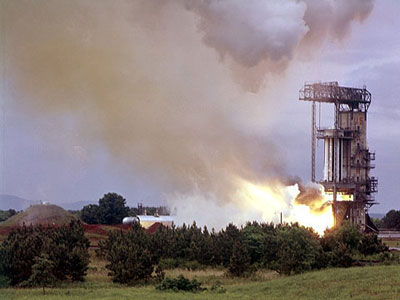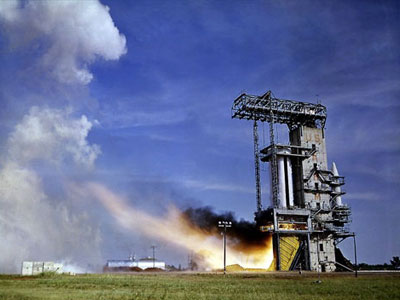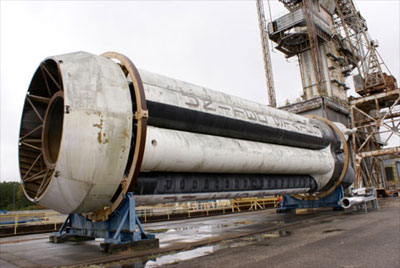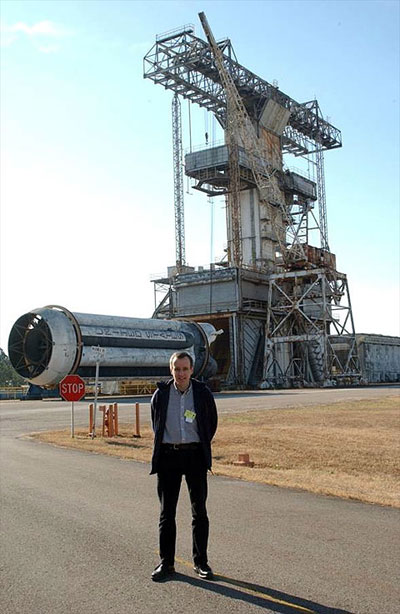|
|

|
|
Author
|
Topic: March 28, 1960: First Saturn stage test firing
|
Robert Pearlman
Editor Posts: 43576
From: Houston, TX
Registered: Nov 1999
|
 posted 03-29-2010 01:55 PM
posted 03-29-2010 01:55 PM
   
From the collectSPACE Today in Space History blog: 50 years since Saturn's first lightSunday was a half-century since the first test fire of the first Apollo Saturn I booster stage. What ultimately evolved into the rocket stage that launched the first Apollo astronaut crew into space began as the Saturn test booster (SA-T), which on March 28, 1960 was used to test two H-1 engines (eight such engines would be used to launch the Saturn I and IB rockets). The 7.83-second firing took place in Alabama on the Army Ballistic Missile Agency's (later NASA Marshall Space Flight Center) test stand. Today, 50 years later, the SA-T test booster is displayed at the test stand's base. Finding a photograph of that first test fire is more difficult than one might expect, as Alan Lawrie, author of Saturn and Saturn 1/1B and Saturn 1/1B , explains: , explains: There are no photos that are positively identified as being that first firing. However, here are two photos of two of the first eight firings (between March and June 1960) as evident by the test stand having "US Army" painted on its side (the Army Ballistic Missile Agency became Marshall Space Flight Center in July 1960). The first photo may possibly be that first firing. It is on the NASA image site but displayed back to front (corrected here). The fact that it's a bit blurred and that it has an ID number (9808562) that shows that it was located and archived much later shows that someone made an effort to save this photo even though there are clearer photos of this type of test.  
Credit: NASA
As mentioned above, the Saturn test booster (SA-T) stage today sits on display next to its test stand in Huntsville, Alabama. 
Credit: Mike Jetzer
Author Alan Lawrie with SA-T. Credit: Alan Lawrie
|
Apollo Redux
Member Posts: 346
From: Montreal, Quebec, Canada
Registered: Sep 2006
|
 posted 03-30-2010 02:00 PM
posted 03-30-2010 02:00 PM
   
Very cool. |
micropooz
Member Posts: 1532
From: Washington, DC, USA
Registered: Apr 2003
|
 posted 04-01-2010 08:03 PM
posted 04-01-2010 08:03 PM
   
Interesting that the second photo down shows a Juno launch vehicle on the other side of the test stand from the Saturn stage. |
mikej
Member Posts: 481
From: Germantown, WI USA
Registered: Jan 2004
|
 posted 04-02-2010 08:00 AM
posted 04-02-2010 08:00 AM
   
The Static Test Tower was built as a two-position test stand to test Jupiter missiles. It underwent several improvements, the east position (Static Test Tower East, or STTE) being upgraded for Saturn I and then Saturn IB first stages. The west position was also upgraded and hosted a number of F-1 engine tests prior to the completion of the F-1 test stand in the West Test Area.The Redstone Arsenal's history web site has several pages of old STT photos, in various stages of construction and renovation (be sure to click through to "next page"). "US ARMY" was only painted on the north side, so you can tell whether a photo of a given test was performed in the east or west position. I've often wondered whether the Juno IIs frequently seen in the west position were there for anything more than decoration -- i.e., if any Juno II static tests were performed during the Saturn test program. Just from a risk standpoint, I'd tend to think that a catastrophic failure in one test position (especially of a Saturn) would mean a bad day for the other test position. | |
Contact Us | The Source for Space History & Artifacts
Copyright 2020 collectSPACE.com All rights reserved.

Ultimate Bulletin Board 5.47a
|
|

|
 advertisement advertisement

|















